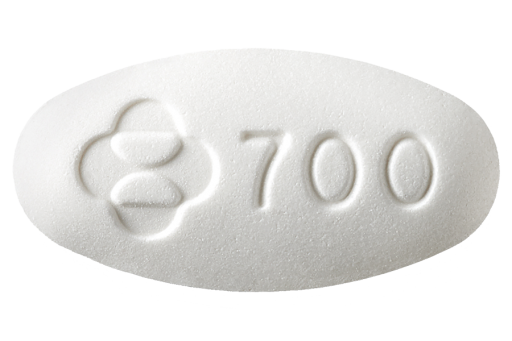Pifeltro
100 mg doravirine DOR (NNRTI)

Standard Dose
One tablet, once daily with or without food, in combination with other antiretroviral drugs in people taking HIV treatment for the first time (treatment-naïve) or to replace the current antiretroviral regimen in those who are virologically suppressed (HIV viral load less than 50 copies/mL) on a stable antiretroviral regimen with no history of treatment failure and no known viral substitutions associated with resistance to doravirine. Must be taken in combination with another antiretroviral(s) from a different drug class.Approved for adults and children who weigh at least 77 pounds (35 kg).
Take missed dose as soon as possible, unless it is closer to the time of your next dose. Do not double up on your next dose. No dosage adjustment necessary for mild, moderate, or severe kidney impairment or for mild or moderate liver impairment. Pifeltro has not been studied in people with severe liver impairment.
- See package insert for more complete information on potential side effects and interactions.
Manufacturer
Merck and Co.pifeltro.com
(800) 672–6372
AWP
$2,012.40/monthPotential Side Effects and Toxicity
Most common side effects (an incidence of 5% or greater) observed in Pifeltro studies were nausea (7%), headache (6%), fatigue (6%), diarrhea (6%), and abdominal pain (5%). Rash, which is a common side effect of the NNRTI class, was reported in up to 2% of the studied population. In the DRIVE-AHEAD study, an in-depth analysis examined the incidence of neuropsychiatric adverse events associated with a doravirine-containing regimen (Delstrigo) compared to Atripla. Neuropsychiatric events, such as depression, sleep disturbances, and dizziness, are another common side effect of NNRTIs. Doravirine did not appear to negatively affect cholesterol in studied populations.
Potential Drug Interactions
When taken with rifabutin (used for TB and MAC treatment), increase the Pifeltro dose to one 100 mg tablet twice a day, approximately every 12 hours. The following are among the medications that may lower the blood levels of Pifeltro, and therefore may decrease its effectiveness, and should not be used with Pifeltro: the anticonvulsants carbamazepine, oxcarbazepine, phenobarbital, and phenytoin; the androgen receptor inhibitor enzalutamide; the antimycobacterials rifampin and rifapentine; the cytotoxic agent (cancer drug) mitotane; and the herbal St. John’s wort. Tell your provider or pharmacist about all medications, herbals, and supplements you are taking or thinking of taking, prescribed or not, as there are other drug interactions that are not listed here.
More Information
FDA approved in 2018, doravirine may be an option for people who have developed drug resistance to other NNRTIs. A single-tablet regimen (STR) containing doravirine was also approved in 2018; see Delstrigo page. Delstrigo, however, contains the older version of tenofovir, tenofovir DF. The standalone Pifeltro allows people to take it with the newer tenofovir alafenamide (TAF), found in Descovy, which has potentially less long-term renal and bone toxicity. On the other hand, TAF is associated with weight gain. Of course, the use of Pifeltro means the necessity for an extra pill, such as Descovy, or maybe more than one extra pill, depending on the regimen being used. Pifeltro was found to be non-inferior to boosted darunavir (Prezista) as well as efavirenz (Sustiva), with data now out to 96 weeks (2 years). Doravirine was superior to boosted darunavir at week 96 in terms of virologic suppression, but it should be noted there was a higher rate of study discontinuation in the boosted darunavir group. Doravirine is a non-nucleoside medication, and it should be noted that this drug class typically has a lower barrier to resistance, as well as extensive cross-resistance. Additionally, the emergence of resistance at the time of virologic failure has been reported with doravirine. Doravirine has tolerability advantages over efavirenz and has relatively favorable lipid effects when compared to both boosted darunavir and efavirenz. It also has fewer potential drug interactions than efavirenz or rilpivirine, and, unlike rilpivirine, virologic efficacy is not compromised among people with high baseline viral loads or low CD4 counts. Doravirine has not yet been directly compared to integrase inhibitor-based regimens in clinical trials. In a new DHHS statement last year, “In a cross-trial analysis, DOR was not associated with weight gain compared with [efavirenz] 600 mg or boosted [darunavir].” For individuals with HIV-2, commonly found in some other countries, an NNRTI would not be recommended as HIV-2 is inherently resistant to NNRTIs. No adequate human data are available yet to establish whether or not Pifeltro poses a risk to pregnancy outcomes. However, it is predicted that blood levels of Pifeltro are lower in pregnant women, which may reduce the effectiveness of the medication. Pregnant individuals can voluntarily enroll in the Antiretroviral Pregnancy Registry through their provider; go to apregistry.com.
Doctor Comments
Dr. Melanie Thompson:
Doravirine was never tested head-to-head against INSTIs, therefore is not recommended for first-line therapy in most circumstances. It is combined with TDF and 3TC as Delstrigo. In clinical trials, doravirine was associated with less nausea and rash and fewer neuropsychiatric side effects such as dizziness, abnormal dreams, and sleepiness, than efavirenz, and with less diarrhea than ritonavir-boosted darunavir. LDL, triglycerides, and total cholesterol increased with efavirenz and ritonavir-boosted darunavir but decreased with doravirine. In a cross-study analysis, at week 48, average weight increase was more with doravirine (1.7 kg) than with efavirenz (0.6 kg) and about the same as with ritonavir-boosted darunavir (1.4 kg), but all were similar at week 96.
Some drugs can’t be taken with doravirine, including some seizure and tuberculosis medications, St. John’s wort, and the androgen receptor blocker enzalutamide. There are other drugs that have manageable interactions, so talk with your HIV care provider about any other drugs you take.
Doravirine is not recommended in pregnancy due to insufficient data.
The monthly wholesale acquisition cost of doravirine is $1,597.
Activist Comments
Activist Joey Wynn:
Pifeltro can be used regardless of viral load, taken without food, and does not interact with proton pump inhibitors. It is definitely an option for people that developed drug resistance to other NNRTIs. Pifeltro allows people to take it with other newer combinations. In resource constrained jurisdictions, this mediocre option may save the bank if it is limited in funding.


